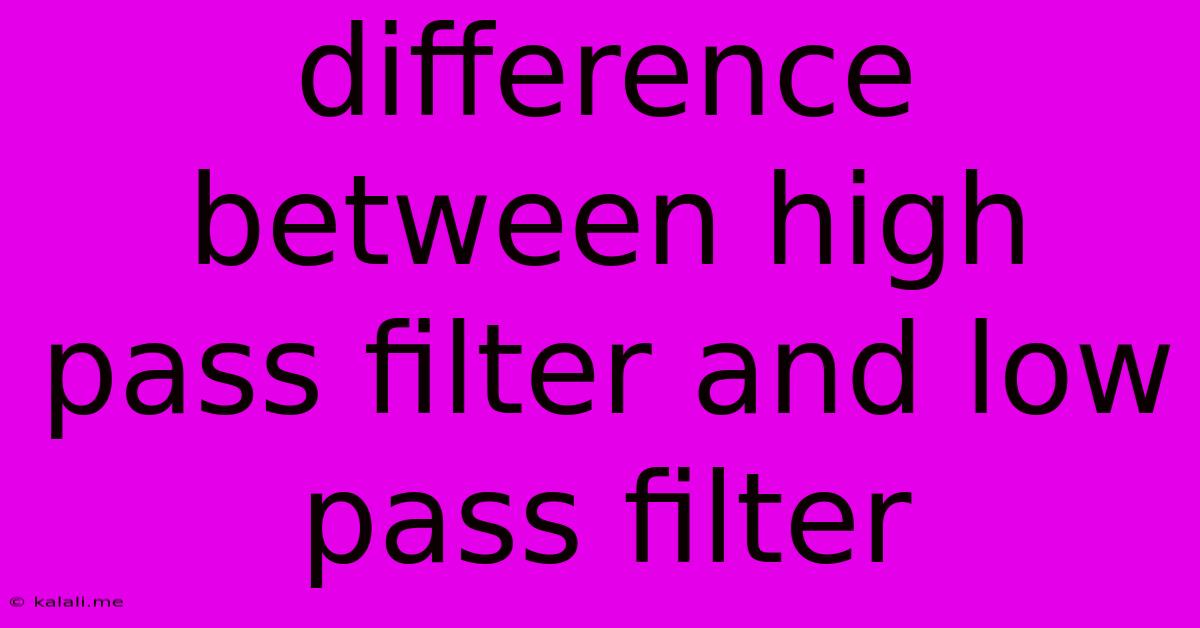Difference Between High Pass Filter And Low Pass Filter
Kalali
Jun 15, 2025 · 3 min read

Table of Contents
High Pass Filter vs. Low Pass Filter: Understanding the Differences
Meta Description: This article clarifies the key differences between high-pass and low-pass filters, explaining their functionality, applications, and how they impact signal processing. Learn to identify which filter is best suited for your needs.
High-pass and low-pass filters are fundamental components in signal processing, used to selectively allow or block frequencies within a signal. While both manipulate the frequency spectrum, their actions are opposite. Understanding their differences is crucial for anyone working with audio, image processing, or any field involving signal manipulation. This article will break down these differences, clarifying their functionalities and applications.
What is a Low-Pass Filter?
A low-pass filter allows frequencies below a specified cutoff frequency to pass through while attenuating (reducing) frequencies above that cutoff. Imagine a sieve: it lets small particles (low frequencies) pass but blocks larger ones (high frequencies). The cutoff frequency represents the point where the filter begins significantly attenuating the signal. The transition from passband (frequencies allowed) to stopband (frequencies blocked) isn't always abrupt; it's often a gradual slope. This slope is characterized by the filter's order. Higher-order filters offer a steeper transition.
Applications of Low-Pass Filters:
- Audio Processing: Removing high-frequency hiss or noise from an audio signal.
- Image Processing: Smoothing images by reducing high-frequency details (noise or sharp edges).
- Data Acquisition: Filtering out high-frequency noise from sensor readings.
- Anti-aliasing: Preventing aliasing artifacts in digital signal processing.
What is a High-Pass Filter?
Conversely, a high-pass filter allows frequencies above a specified cutoff frequency to pass through while attenuating frequencies below it. Think of it as the opposite of the low-pass filter – it blocks the "low" and lets the "high" pass. Again, the transition between the passband and stopband is characterized by the filter's order.
Applications of High-Pass Filters:
- Audio Processing: Removing low-frequency rumble or hum from an audio signal. This is often used to eliminate unwanted background noise.
- Image Processing: Sharpening images by enhancing high-frequency details (edges and textures).
- Data Acquisition: Removing slow drifts or baseline wander from sensor data.
- Signal Enhancement: Isolating high-frequency components of a signal for further analysis.
Key Differences Summarized:
| Feature | Low-Pass Filter | High-Pass Filter |
|---|---|---|
| Frequencies Passed | Below cutoff frequency | Above cutoff frequency |
| Frequencies Attenuated | Above cutoff frequency | Below cutoff frequency |
| Effect on Signal | Smooths, removes high-frequency content | Sharpens, removes low-frequency content |
| Typical Applications | Noise reduction (high frequency), smoothing | Noise reduction (low frequency), sharpening |
Choosing the Right Filter
The choice between a high-pass and low-pass filter depends entirely on the specific application and the nature of the signal being processed. Consider the unwanted frequencies you aim to eliminate or the desired frequencies you want to preserve. For instance, to clean up noisy audio, you might use a high-pass filter to remove low-frequency hum and a low-pass filter to remove high-frequency hiss. Understanding the characteristics of each filter is essential for effective signal processing.
Beyond the Basics: Band-Pass and Band-Stop Filters
It's important to note that these are not the only types of filters. Band-pass filters allow only a specific range of frequencies to pass, while band-stop filters (also known as notch filters) attenuate a specific range of frequencies. These filters are often created by combining high-pass and low-pass filters. Understanding the fundamental differences between high-pass and low-pass filters provides a strong foundation for understanding more complex filter designs.
Latest Posts
Latest Posts
-
Ammeter Is Connected In Series Or Parallel
Jun 15, 2025
-
What Is A Antonym For Abundant
Jun 15, 2025
-
Triangles Abc And Def Are Similar
Jun 15, 2025
-
The Breaking Down Of Rocks Is Called
Jun 15, 2025
-
Which Vitamin Is Mismatched With Its Deficiency
Jun 15, 2025
Related Post
Thank you for visiting our website which covers about Difference Between High Pass Filter And Low Pass Filter . We hope the information provided has been useful to you. Feel free to contact us if you have any questions or need further assistance. See you next time and don't miss to bookmark.